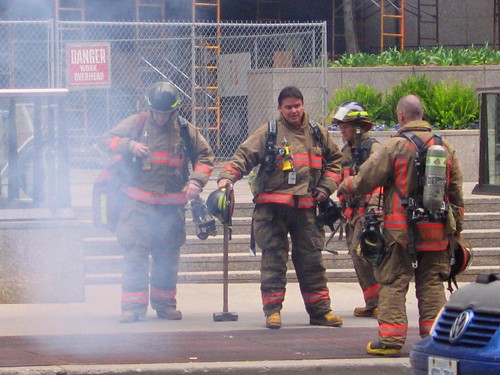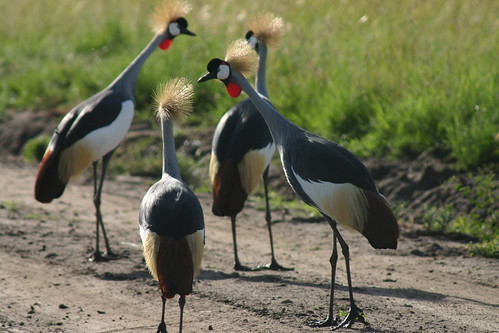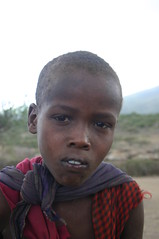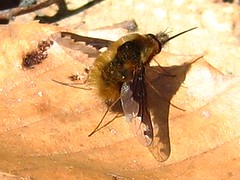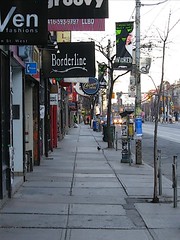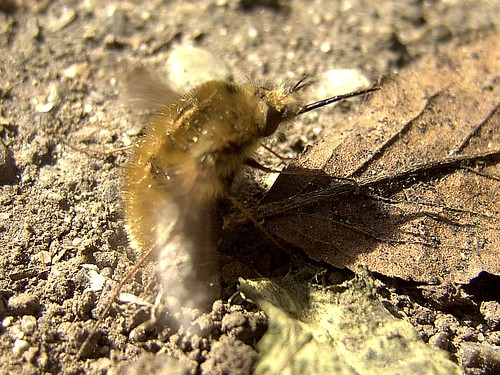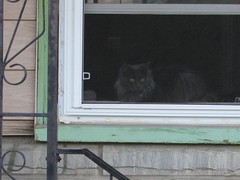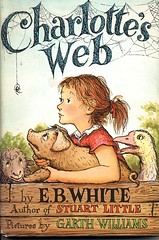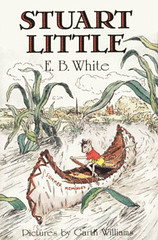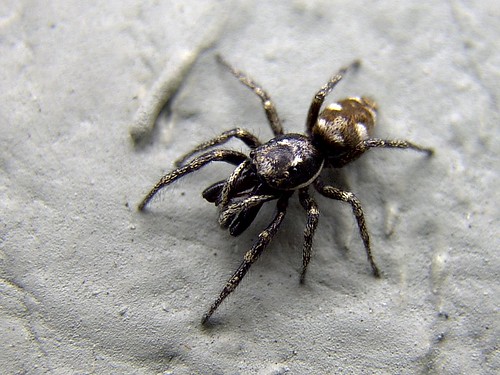Friday, April 29, 2005
Linux Journal meta article by Doc Searls
This past week Nancy and I have been doing a lot of thinking and talking about Janneke. She's very bright but has been having tough time under her teachers' scrutiny because she does not perform propertly at all times with her school chores. Before I go on I'd like to say that there are definately skills Janneke needs to improve on. The problem is that there is a risk that this will not be the focus, rather the focus is in danger of becoming "helping" Janneke fit into the classroom environment better.
I do believe that one can learn a great many things in school if there is a good relationship between teacher and student. School can be damaging, however, if, when one fails to perform or behave as per the norm, one is labelled as having a problem. This, to some extent, is happening with Janneke. I'd like to stress that this labelling is not uniform and that we think that if we are proactive we can make things work out for the best of Janneke.
Institutions, on their own are lazy shells intent on sucking you in and forming you to their mould. Because it is essentially stupid, the tendancy of an institution is to try to make people fit its needs rather than the other way around. It doesn't know anything else. Schools are also institutions that need to process people, set up to rank and score them along the way to producing their finished product. This can lead to problems, especially if the school is not filled with staff who work to make the school a place focussed on the individual needs and gifts of its students. Notice that you need good people. Take away the dedicated, skilled staff and all you're left with is the ranking, the bell curve. As schools fit into school boards fit into universities fit into standardized test scores fit into job applications, the wisdom of the human is more and more replaced by the empty stupidity of the institution.
We'd like to protect our children from this as much as possible and outfit them to think for themselves so that when they are older they can protect themselves and learn for themselves.
Thursday, April 28, 2005
Hyacinth in lawn
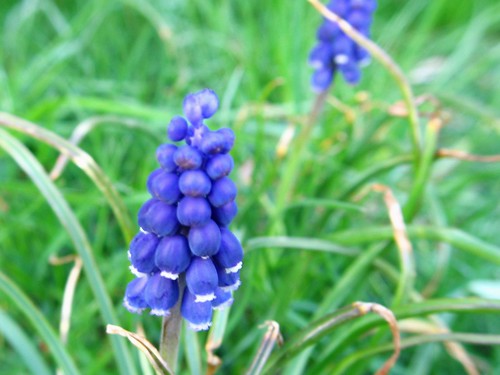
Latin name: Muscari americanum
Got the Raynox closeup lens and extension tube I'd ordered today. This picture was taken with the new setup. Light wasn't too good (the photo was taken at 7:30 or so), so sharpness and shutter speed suffered. I think, though, that the new lens should enable me to get some very good macro shots.
From this picture you'd think that my lawn is a verdant wonderland.
Wet street by morning

This picture turned out quite well. It's a one second exposure taken at around 5:25 AM yesterday. The street was wet and had a nice gloss to it and the lights came out with an interesting flare effect as well. I kept the camera still by placing it on my cloth camera case on the pavement. Having the pavement as part of the shot makes things more interesting I think.
Depleted Uranium
In fact, Morris pointed out, the vast majority of Gulf War DU
exposure cases didn't occur in combat, but were people who
toured the battlefields and climbed in and on vehicles struck by
DU munitions.
 All of the particles produced remain ad nauseum, literally. Iraqis aren't so able to keep away from depleted uranium. Birth defects in Iraq are up 20% over the past two years. The increase is attributed to depleted uranium and pollution. Is there some kind of flaw in the logical reasoning that breating in radioactive heavy metals year after year is bad for you and thus that it should not be dispersed in the first place? There's no flaw, but a different logic drives whether or not this stuff should be used in the first place. What we get is the decision to use depleted uranium, minimum care for our guys, and the ignoring of effects on the long-term health and welfare for the poor sods who live in the combat zone. It's all driven by the increase in kill efficiency, also mentioned in the warning letter:
All of the particles produced remain ad nauseum, literally. Iraqis aren't so able to keep away from depleted uranium. Birth defects in Iraq are up 20% over the past two years. The increase is attributed to depleted uranium and pollution. Is there some kind of flaw in the logical reasoning that breating in radioactive heavy metals year after year is bad for you and thus that it should not be dispersed in the first place? There's no flaw, but a different logic drives whether or not this stuff should be used in the first place. What we get is the decision to use depleted uranium, minimum care for our guys, and the ignoring of effects on the long-term health and welfare for the poor sods who live in the combat zone. It's all driven by the increase in kill efficiency, also mentioned in the warning letter:Morris said the U.S. armed forces first used DU munitions andWow! That's awesome!
armor during the Gulf War and decisively demonstrated its
effectiveness. In one incident, a DU round went through a bermed
revetment, through an Iraqi vehicle and through the berm on the
far side. In another incident, three Iraqi vehicles ganged up on
and couldn't stop a lone Abrams tank -- the Abrams crew
destroyed all three Iraqis.
Wednesday, April 27, 2005
Scottandrew
Undefended no longer
Minuteman Project leaders said their volunteers alerted U.S. authorities to more than 330 cases this month of illegal immigrants crossing into the United States across a 37-kilometre stretch of Arizona's southern border. Now they plan to extend their patrol along the rest of the border with Mexico and are helping organize similar efforts in four states that neighbour Canada.Hope those minute men don't get stepped on as they patrol.
David Niewert at his Orinicus blog often discusses the munutemen and other specimens of clear thinking. Perhaps they do think clearly, but not rationally.
Tuesday, April 26, 2005
Flickr API for Ruby
# see code to understand stuffWell, fortunately, I can understand the code, which is straightforward enough but bears the mark of Python styling, with underscored variable names and methods indicating "hidden".
@__id = idPerfectly OK code, but not how I'd do it. Nonetheless, all I need is a decent library so that I can build some commandline tools so that I can do things like:
@__owner = owner
@__dateuploaded = dateuploaded
ls -1 . fam*.jpg| xargs -i flickr_upload --family=1Not pretty if you're not a commandline person, but it's nice to be able to just run the command and go have supper rather than upload six at a time through the web interface.
--public=0 --tags='family' {}
Hope to get something going in the next week along this road.
Babbleflab
While The Globe offers far more free news content than the [Wall Street] Journal does, readers must register and pay for premium material. That assures advertisers they are getting a “tight niche audience,” said Sandra Mason, vice-president of The Globe's on-line businesses.Like the Journal, The Globe can then charge higher rates for its on-line ads than other sites, she said.
Ms. Mason said one reason the paper has opted for a hybrid model with lots of free material is to ensure potential future Globe readers — in a younger demographic than current readers — are exposed to the paper's content.
So, the Globe can sell ads for more if those reading the articles have paid to read them. It this the whole story? Perhaps the Globe is also trying to use the subscription model online as well as a stream of revenue. They are part of the story and not necessarily able to report from a neutral perspective. Do we really expect to see further text like "Ms. Mason wouldn't comment on how much revenue The Globe makes through subscriptions"? No. They just don't dig deeper because they are in conflict of interest.
I don't know what will work for traditional media in terms of bringing in revene. The thing is, there's no law stating that traditional media should be guaranteed a place now and forever or that alternative news sources cannot displace them or force them to change.
Skunk cabbage

Latin name: Symplocarpus foetidus
The lowly skunk cabbage is made not-so-lowly by the fact that when it is at the height of its greenness there is precious little other green to be found. Its flowers, barely visible in this picture, are unpretentious by also somewhat exotic, minarets open on one side to reveal a sphere within dotted by stamens like cloves embedded in an orange.
I like the striking contrast between the green of the leaves and the brown of last year's fallen sodden forest cover. I also like the shinyness and the metaphorical contrast between life and death.
Again with this picture I played around with colour contrast and brightness. This, to my mind, has an effect similar to the use of a warm flash (no flash was used). I also added a bit of sharpening, although not much was needed.
Marsh Marigold

Latin name: caltha palustris
Here's another shot of Marsh Marigolds. Note the darker green in this image. I tried upping the colour contrast a bit. The results are quite nice. It's a fine line, finding the divide between colour accuracy and the luxiouriance of rich colour. I do find that bright lighting can wash colours out and that working with colour contrast and brightness can go a long way toward re-balancing things to be more like you actually saw them.
What I like about this shot is that the brilliance of the yellow Marsh Marigold flowers is balanced by the richness of the flowers' leaves. A nice effect.
Monday, April 25, 2005
Marsh Marigold

Latin name: caltha palustris
I'm glad I was wearing my big rubber boots on our trip to St. John's conservation area yesterday. I was able to wade in and take some shots of Marsh Marigold. It's very pretty. I have to figure out yet how to take clear shots of subjects with high relative luminance like this Marsh Marigold's flowers.
Red trillium not yet fully opened

Latin name: trillium erectum
Went to St. John's conservation area with the kids on Sunday. The weather was overcast with very light and spotty rain, but the lighting was pretty good for photos. The hepatica seems to be gone already. Red trilliums are starting to bloom and white trilliums are almost there.
Looking at this picture of a red trillium, I see that the flower case is a bit washed out. I'm starting to get pickier, probably because I'm getting to know my camera and more about lighting, arpetrure, exposure time, etc.
Fiddling around with images last night I found that pumping up the colour contrast gives me an effect similar to what I've seen on others' photos on Flickr, namely exaggerated rich colours. It's pretty, but for me crosses the line into fibbing for most of what I do that's intended to convey what I saw non-metaphorically. I'll do my best to stay true to what I saw while reserving the right to intervene to get to that point.
Saturday, April 23, 2005
Daffodils
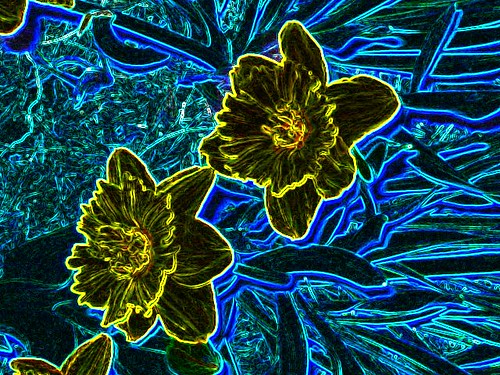
The shot originally had a blue cast because of the white balance mode I had set (tungston). The floweres are also actually white. I used the Gimp's Sobel edge detect filter to get the high contrast and bumped up the saturation as well. It can be seen that by far the dominant colours are cyan, blue, and yellow, more or less in that order. The picture was taken at about 5:15 am on the 23rd of April (yesterday barely) on my way to the bus stop. I'm in general using the dark lighting conditions to experiment with shutter speed.
I think the colours worked out the way they did because of the adjustments to colours that are made under the tungsten white balance mode for the camera. Since the camera workes with reflective light it deals in the subtractive colour model. Tungsten lighting is yellowish. To bring a photo back to a neutral white baseline you need to subtract yellow from its colours. This makes greens go to blue and yellows diminish (I think). Taking a photo with no ambient light and the assumptions of tungsten lighting results in a skewed-colour image.
Investigating smoke from subway
Friday, April 22, 2005
Gaggle
My sister says that the picture quality is all due to her camera, but I don't think so. She made excellent choices and framed them very well.
It's always been a dream of mine to go visit Ellesmere Island. Ellesmere would be a great place to get lots of shots of ice fields and barren, rocky landscapes. Tanzania is an amazing place to get picture of wildlife.
That's rum
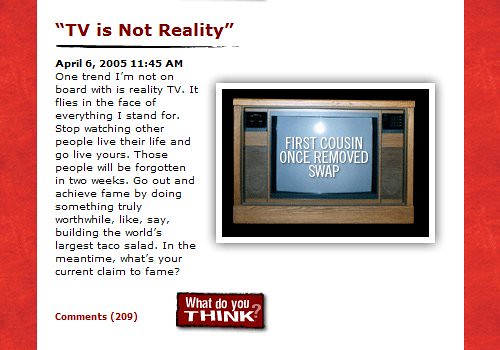
The blog of Captain Morgan (the rum logo guy). I think it's been decomissioned or perhaps sent back to a focus group. I had a hard time getting to it. Like Barbie's blog, completely fictitious. In this entry, the captain advises us to avoid reality TV because it's just not real. He should talk. Or maybe not.
Rosie O'Donnell blog
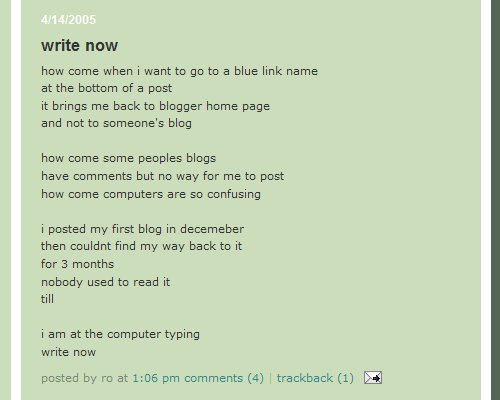
Here's a bit from Rosie O'Donnell's blog. I post it here as an image because she might someday wake up and realize how atrocious it is and then remove it.
Barbie blog
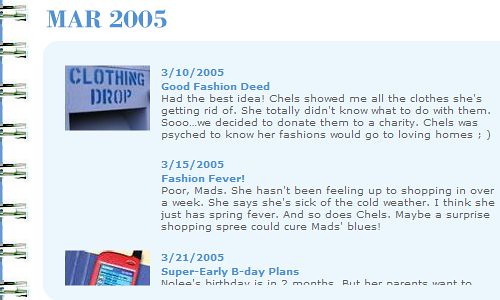
Yes, Barbie has a blog, written by a ghost writer I suspect (her hard plastic hands aren't flexible enough to type), and guided by a panel from Mattel that probably meets every Thursday and fails to see the total wierdness of it all. I post it here in image form because it's done in Flash. Not real, just like Barbie.
David Duchovny blog
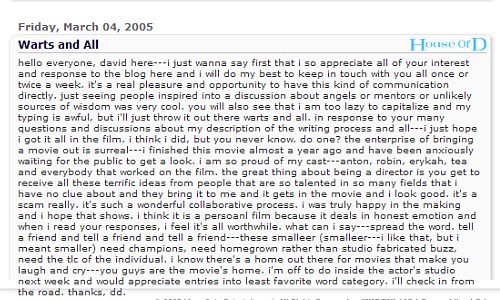
Here's a capture of the blog of David Duchovny (the atonic voice guy from X-files) related to his new movie House of D. I'm posting an image since it's probably a throwaway thing related to "getting in touch" with potential viewers of the film, not a real attempt at long-term communication, or so my jaded self tells me.
Thursday, April 21, 2005
Masai youth
Wednesday, April 20, 2005
Modified blog layout
English Cut tailor
Tuesday, April 19, 2005
Our new piano

From the Rischler site page.
| Action: | Direct blow action, rock maple wood parts. | |||
| Tuning Pins: | Nickel plated steel, machine cut, blue steel. | |||
| Hammers: | Imported Royal George felt, UK. | |||
| Keys: | Sold spruce, ivorene cover. | |||
| Plate: | Precision cast. | |||
| Finish: | Polyester, 4 coats of polyester resin, two coats of polyurethane. | |||
| Soundboard: | Cross banded laminated quarter sawn select spruce. | |||
| Pinblock: | 22 layer ply block beach wood by Dehonit, Germany. | |||
Ours is shinier, whether that makes it more beautiful or not. It certainly makes it look more dusty faster.
Round Lobed Hepatica

Latin name: hepatica americana.
This is an amazingly fabulous flower. It apparantly grows in Ontario woodlands in springtime. Its leaves develop after the flowers are bloomed out. Its stalk is hairy to help it keep warm. We found this flower at St. John's conservation area, a lovely hilly place full of beech and tulip and oak trees and wetlands.
Music to our ears
 On or move to Ontario the movers destroyed our Yamaha Clavinova electronic piano. It's replacement value is about forty five hundred dollars, although that's not what we paid for it. The contents of the move were insured against damage, so, after a long time of assesment, we were given the go-ahead to get a replacement for the keyboard up to a value of thirty-five hundred dollars before tax. It's a little disturbing how happy Nancy was about this. She found a Rischler piano within the budget and it was delivered yesterday. It sounds great. I did not expect to be an owner of a brand new piano any time soon. This is a nice counterbalance to the large amounts of academic work Nancy is going through for her MEd.
On or move to Ontario the movers destroyed our Yamaha Clavinova electronic piano. It's replacement value is about forty five hundred dollars, although that's not what we paid for it. The contents of the move were insured against damage, so, after a long time of assesment, we were given the go-ahead to get a replacement for the keyboard up to a value of thirty-five hundred dollars before tax. It's a little disturbing how happy Nancy was about this. She found a Rischler piano within the budget and it was delivered yesterday. It sounds great. I did not expect to be an owner of a brand new piano any time soon. This is a nice counterbalance to the large amounts of academic work Nancy is going through for her MEd.The cabinet for the piano's apparantly made of "rock maple", also known as sugar maple.
I think the piano's a re-branding for the Canadian reseller and is made in a large factory in China that also makes pianos for Yamaha and others. Buying a Yamaha with the same parts from the same factory would have cost us four hundred dollars more. One made in Japan would cost another four hundred. Both options were outside our budget. The Chinese Yamaha would not have bought us anything besides a different logo.
Ontario Flowers site
A skunk in time
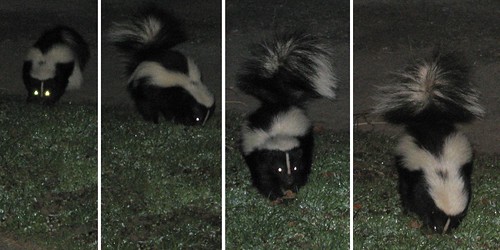
I run into a skunk every few days as I walk to the bus station. It's an interesting if somewhat nerve-wracking experience. Yesterday I decided to be brave and take some pictures of a skunk I ran into. He (or she) made sure I was not too close and then just carried on with business, rooting in the grass for grubs. I've presented the four pictures I took as a sort of storyboard. I was going to present them as a progression of images faded almost to nothing on the left to not at all on the right, but that's a pain and doesn't necessarily present a better story than the simple left to right method I ended up using. I did decide to make the leftmost frame thinner and thicken them as they progressed to the right. Not sure if that made the result look messy or not.
Monday, April 18, 2005
Bee Fly on Beech leaf
Up 'till my 36th year of life, I had not known about the existence of the Bee fly. Now that I do I'm intent on getting good photographs of this springtime oddity.
The Bee Fly, as an adult, drinks nectar from flowers and looks and sounds much like a bee. As a larva, however, the bee fly devours the young of the solitary bee. In order to accomplish this, the Bee Fly emerges early to be ahead the solitary bee's life cycle. The Bee Fly seems to need to stay warm and so is often seen resting on light-coloured objects such as faded leaves or pale coloured walls. This makes it tricky to get a good photograph of, as the background tends to come out too bright and the fly too dark.
Other warmth-maximizing features in this fly include its fuzz, the dar colouration on its body, and the dark colouration on its wings.
Friday, April 15, 2005
Free Tibet Falun Gong
Filtering tends to be triggered by the appearance of certain keywords, rather than a visit to a specific domain name or numeric internet address. The keyword-based filters also allow blogs to keep people from completing posts containing banned topics.You are most easily controlled when you are not aware it's even happening.
Wednesday, April 13, 2005
street scene
Fighting back
There are many natural scientists, and especially physicists, who continue to reject the notion that the disciplines concerned with social and cultural criticism can have anything to contribute, except perhaps peripherally, to their research. Still less are they receptive to the idea that the very foundations of their worldview must be revised or rebuilt in the light of such criticism. Rather, they cling to the dogma imposed by the long post-Enlightenment hegemony over the Western intellectual outlook, which can be summarized briefly as follows: that there exists an external world, whose properties are independent of any individual human being and indeed of humanity as a whole; that these properties are encoded in ``eternal'' physical laws; and that human beings can obtain reliable, albeit imperfect and tentative, knowledge of these laws by hewing to the ``objective'' procedures and epistemological strictures prescribed by the (so-called) scientific method.I got to this article through a Slashdot piece highlighting the acceptance of a randomly generated paper for presentation at a conference. In the spirit of scientific research, the source code for the random paper generator is available for download. Here's the abstract from the paper:
Many physicists would agree that, had it not been congestion control, the evaluation of web browsers might have occurred. In fact, few hackers worldwide would disagree with the essential unification of voice-over-IP and public private key pair. In order to solve this riddle, we confirm SMPs can be made stochastic, cacheable, and interposable.Someone pointed to some drivel on the conference website:
Through WMSCI conferences, we are trying to relate the analytic thinking required in focused conference sessions, to the synthetic thinking, required for analogies generation, which calls for multi-focus domain and divergent thinking. We are trying to promote a synergic relation between analytically and synthetically oriented minds, as it is found between left and right brain hemispheres, by means of the corpus callosum. Then, WMSCI 2005 might be perceived as a research corpus callosum, trying to bridge analytically with synthetically oriented efforts, convergent with divergent thinkers and focused specialists with non-focused or multi-focused generalists.Jargon juggling does not a wise man make.
Related to this is the Plain English group, lobbying for plain English in public infomation.
Nice house on York Street, St. Catharines
The Georgian Style was brought to Upper Canada (Canada, prior to 1867, was known as Upper Canada - Ontario and the west - and Lower Canada - anywhere down the St. Lawrence River) by United Empire Loyalists who had lost everything that they owned in the war between England and the United States (1755 - 1778).St. Catharines does indeed have a strong Loyalist past. Our own home is reminiscent of that style, although not as impressive. Owen Sound, where my mother grew up, has many homes in its downtown area that seem more remeniscent of the Queen Anne style, although I'm no expert.
Tuesday, April 12, 2005
Bee fly laying eggs
Tom Ridge loves RFID
"That's one of the beautiful things about RFID," said Ridge. "It's another security measure embedded in the U.S. economy."Yes, the economy. About seven years ago there was a movie called Enemy of the State starring Wil Smith as a hapless citizen hounded by rogue US federal officers and tracked using little radio chips much like RFID tags. Gene Hackman played a very paranoid ex federal officer who reluctantly helps Smith's character.
It used to be OK to distrust the tendancy of government to track our every move. Now it's ok, especially if it's good for the economy and framed as being aimed at fighting terrorism.
Oops, forgot to add this bit of info:
Ridge recently joined the board of Savi Technology, an RFID contractor for the DHS [Department of Homeland Security].
Macro Photography article
Macro photography is a kind of close-up photography. The classical definition is photography in which the image on film is at least as large as the subject. Therefore, on 35mm film (for example), the camera has to have the ability to focus on an area at least as small as 24×36 mm, as this is the size of the image on the film. This is a magnification of 1:1.
For example, suppose you take a macro photograph of a coin on film. You set the lens for a magnification of 1:1 and move the camera to and fro until the coin is in focus, then take the picture. After you have the film developed, you can place the coin on the film, and you'll see that the coin is exactly the same size as the picture of the coin on the negative or slide.
In recent years, the term macro has come to mean being able to focus on a subject close enough so that when a standard 102×152 mm (4×6 inch) print is made, the image is life-size or larger.
Going back to the coin, you photograph it from farther away. This time, you set the lens to a magnification of 1:4, move to and fro until the coin is in focus, and take the picture. When you compare the coin to the image on film, you see that the real coin is four times as big across as the image. Next, you have a 4× enlargement print made. The enlargement is about 100×150 mm. And when you place the coin on the print, you see that the size of the coin matches the size of the photo of the coin. That is, the image is life-size in the print.
There's more in the article.
Nice site with photo related articles
Colour and photography articles on Wikipedia
RGB
The RGB color model utilizes the additive model in which red, green, and blue light are combined in various ways to create other colors. The very idea for the model itself and the abbreviation "RGB" come from the three primary colors in additive light models.
Note that the RGB color model itself does not define what exactly is meant by "red", "green" and "blue", so that the same RGB values can describe noticably different colors on different devices employing this color model. While they share a common color model, their actual color spaces can vary considerably.
YCbCrYCbCr is a family of colour spaces used in video systems. Y is the luma component and Cb and Cr the chroma components. YCbCr signals (prior to scaling and offsets to place the signals into digital form) are created from the corresponding gamma-adjusted RGB (red, green and blue) source using two defined constants Kb and Kr.
CMYK
CMYK (or sometimes YMCK) is a subtractive color model used in color printing. This color model is based on mixing pigments of the following colors in order to make other colors.
The mixture of ideal CMY colors is subtractive (Cyan, Magenta and Yellow printed together on white result to black). CMYK works through light absorption. The colors that are seen are from the part of light that is not absorbed. In CMYK magenta plus yellow produces red, magenta plus cyan makes blue, cyan plus yellow generates green and the combination of cyan, magenta and yellow form black.
The CMYK article includes a nice howto for converting to and from RGB.
Gamut
In computer graphics, the gamut, or color gamut, is a certain complete subset of colors. The most common usage refers to the subset of colors which can be accurately represented in a given circumstance, such as within a given color space or by a certain output device. Another sense, less frequently used but not less correct, refers to the complete set of colors found within an image at a given time. In this context, digitizing a photograph, converting a digitized image to a different color space, or outputting it to a given medium using a certain output device generally alters its gamut, in the sense that some of the colors in the original are lost in the process.
In color theory, the gamut of a device or process is that portion of the visible color space that can be represented, detected, or reproduced. Generally, the color gamut is specified in the hue-saturation plane, as many systems can produce colors with a wide range intensity within their color gamut; in addition, for subtractive color systems, such as printing, the range of intensity available in the system is for the most part meaningless outside the context of its illumination.
When certain colors cannot be displayed within a particular color model, those colors are said to be out of gamut. For example, pure red which is contained in the RGB color model gamut is out of gamut in the CMYK model.
F-stop
In photography the f-number (focal ratio) expresses the diameter of the diaphragm aperture in terms of the effective focal length of the lens. For example, f/16 represents a diaphragm aperture diameter that is one-sixteenth of the focal length (or the focal length is 16 times the aperture).
The greater the f-number, the less light per unit area reaches the focal plane of the camera film.
In the case of a telescope instead of a camera, one may use a photovoltaic detector or other photometer device, a charge-coupled device (CCD), or the viewer's own eye as a substitute for film. In all cases, the principle is the same: the greater the focal ratio, the fainter the images created (measuring brightness per unit area of the image).
f-stops are a way of representing a convenient sequence of f-numbers in a geometric progression. Each 'stop' is marked with its corresponding f-number, and represents a halving of the light intensity from the one before, corresponding to a decrease of the diaphragm aperture diameter by a factor of √2, and hence an halving of the area of the aperture.
Monday, April 11, 2005
cat in window
Learning from History through Wikipedia
The Liberals have held power for much of Canadian history, although the founding party of Canada was the Conservative party, more sympathetic to close ties with Britain. The Progressive party broke up, but its members were involved in the more Western Social Credit movement and later the Reform and Alliance parties.
One of the things that I find interesting about this is that the Liberals then and now do well by appealing to the middle and taking advantage of the fact that certain members of other parties will jump ship to them from time to time for ideological or pragmatic reasons.
Another interesting thing is that the King-Byng affair involved King appealing to nationalistic feelings in his struggle with Byng. This did not do lasting damage to Byng's reputation, since he was a war hero, but it probably served as a diversion from attention to a financial scandal that the Liberal party was embroiled in at the time. The current Liberal government is also in a minority situation, is opposed by a conservative movement that is in a state of flux, though a converging one, and is also involved in a scandal. It will be interesting to see how things pan out.
Saturday, April 09, 2005
USB hotplug
Bambi's perfect tan
Someone's making money off the ad space, but we all pay in terms of the change to our visual landscape. I'd not want no colour or ads, but what is a good balance?
This is one I'd classify as un-subtle, but then how else do you advertise tanning oil that is supposed to make you look fantastic?
The tanning oil ad has a simple message. Use this and you will be sexy, bronzed, youthful. Some ads have a more complicated message because they have to overcome problems with thier images. SUV ads fit in this category. They often go to great lengths to show that you can use these gas-guzzlers that pollute the world to visit and experience nature, often probably causing erosion or damaging fish spawning streams in the process. SUV ads often suggest that you can view the world much as a general views a battle, from on high and from a position of safety while still enjoying the excitement of it all. Robutusson tries to differentiate itself from other cold remedies by suggesting that invoking its name is about the same as saying "bless you", a statement originally used in an effort to ward off the plague. Breaking ads down can be great fun, since the underlying message is often hilarious. Perhaps we don't because it's tiring to do constantly or because we don't mind the bait.
As a side note, I actually wrote the company that makes Robutusson, asking what one should say if a person has cancer. Would Robutusson or another product name be appropriate? After this initial sarcasm I told them that I did not appreciate having a product name supplanting the name of God for purposes of product promotion. They replied telling me that in the testing of the ad customers had responded favourably. That's what it all boils down to. "Will it sell product?".
Friday, April 08, 2005
USB setup for GPhoto on Linux
Charlotte's Web
She had to draw a picture in the middle of a page, and around the edges write things like a one line summary, the author, characters, favourite scene, etc. It's cute. I'll take a picture and post it.
Janneke was not much phased when Charlotte died. She'd already seen that in the cartoon.
Stuart Little
When I read it as a child I didn't like it as much as Charlotte's web, probably because I'm sentimental about sad stories. I used to laugh at my mother when she'd cry during Little House on the Prairie, but I think that I am like that too.
Anyway, I am enjoyign Stuart Little very much this time around. The level of English employed puts more "modern" books to shame.
New Camera
Havn't had much chance yet to take interesting pictures with it, since I come home at 6:30 when the light's bad and my kids' hair is messy and their faces have crumbs on them. Will be going to the park this weekend with them and should get some good chances to take some pictures then.
Yahoo 360
So, with my Flickr account I'm allied with Yahoo and with my Blogger accuont I'm allied with Google. Fine by me. Both companies are more or less here to stay, unlikely to do irritating things with the services, and pretty in tune with the needs and preferences of their users. I just hope that Flickr becomes meshed with Yahoo but not engulfed. It's great the way it is. I see it as adding more value to Yahoo than vice versa.
Male Zebra jumping spider
Flickr and blogging
This morning I came over to blogger to look around and realized I've got a three or so year old account already. It's more polished than before (being owned and funded by Google now must help with this), so I decided to do my blogging here. I think it'll work.
